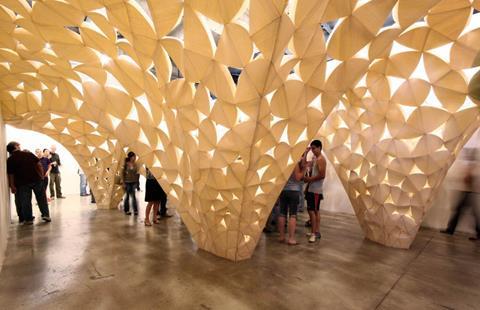Concrete Geometries: How Spaces Move People features 20 projects by a group of international students, architects and designers

The Architectural Association School in London is challenging contemporary thinking on architectural space.
Concrete Geometries: How Spaces Move People follows on from the AA School’s research clusters programmes that saw students, staff and architects working together to discover ways in which we can change attitudes towards space, too often created out of technological convenience rather than how people interact with their environment in real life.
Featuring 20 projects by a group of international architects and designers, the exhibition looked at the relationship between people and built spaces using recent international design, architecture and art projects as case studies.
Marianne Mueller, co-director of the cluster and diploma unit master at the school, said: “This topic seems quite an obvious thing to be exploring, but it is not a discussion that is being held in architecture today.
“By involving designers and artists we are able to rethink our practice on the creation of space. Digital design has provided architects with new tools to experiment with the use of space. We need to challenges our current thinking of space and how we as architects create it.”
The exhibition featured a corridor so narrow that strangers brush shoulders, a platform through a densely inhabited house that challenges the relationship between inhabitant and visitor, and a room reshaped through a graphic pattern.
Research began in January 2010 with an international call for submissions exploring how geometric aspects of space, such as size, shape or relative position of figures, are perceived and influence behaviour in a very real sense. From the 415 entries received, 30 were chosen for further research and 20 selected for the exhibition:
- Room Drawing Installation by Christine Rusch of Germany transforms the perceived space of a room using graphic patterns on its walls.
- Connecting Corridor by Dutch designers Studio Elmo Vermijs connects two buildings, the space too narrow forcing users to interact.
- Brunne strasse 9 by German architects Brandlhuber + ERA is inspired by the legal space guidelines governing the site.
- House Installation Project by British artist Fran Cottell is set in an existing domestic setting, where a raised platform acts as a walkway for visitors, bringing into play conflicting and contradictory power relations.
- Dymaxion Sleep by Canadian architect and artist Jane Hutton and Adrian Blackwell is a structure of nets suspended over a garden which changes the viewer’s fundamental spatial relationship to plants.
Concrete Geometries: How Spaces Move People is on from 6-27 May, 2011 at the AA School, 36 Bedford Square, London, WC1B 3ES



























No comments yet